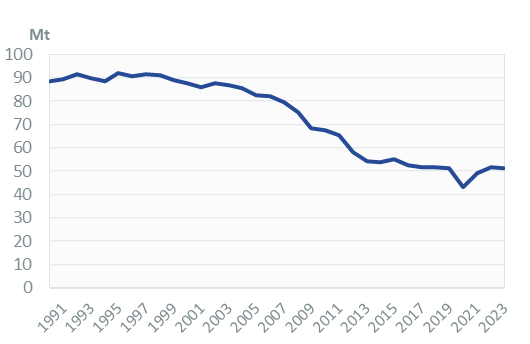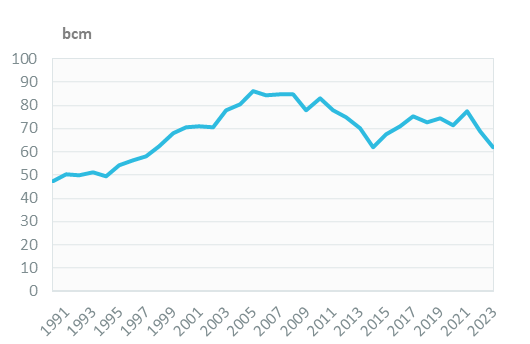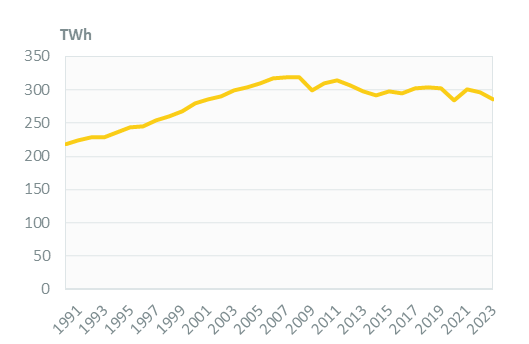-
-
 Energy and Climate Databases
Energy and Climate Databases- The most comprehensive and up-to-date annual energy database.
- Monitoring of technology providers in H2 supply chain.
- Monthly energy data on key energy markets.
- The most reliable and up-to-date power generation database.
- The essentials of LNG trade at your fingertips.
- Global monitoring of new and existing refineries.
- Analyse energy consumption and efficiency trends at world level. Benchmark countries.
- Have your database developed by a recognised expert of both energy and IT.
-
 Energy - Climate Forecasts
Energy - Climate Forecasts- Instant access to energy and emissions forecasts.
- Strategic, annual wholesale price projections backed by Enerdata's energy modelling expertise and our globally recognised POLES model.
- Wedges module showing a breakdown of the levers enabling to reduce emissions between two scenarios.
- Unique, independent projections of consumption by end-use.
- GHG Marginal Abatement Cost Curves.
- Benefit from proven models to draw your own energy scenarios and anticipate tomorrow’s challenges.
-
 Market Intelligence
Market Intelligence- 110 Energy and climate country reports
- A newsletter to receive the latest updates on evolving technologies and policies.
- Global energy news and analyses curated daily.
- Enerdata’s experts bring you the essentials about your market and competitors.
-
-
-
 Market Analysis
Market Analysis- Understanding key consumption trends and drivers across sectors.
- Granular and exclusive insight to address the most pressing business and strategic issues.
- Expertise in strategic and business intelligence, with fine-tuning to the market’s specificities.
-
 Energy - Climate Scenarios
Energy - Climate Scenarios- Providing the outlook of an energy commodity in mid to long term time horizons.
- Sector and driver specific energy demand forecasting.
- Assess the evolution of energy prices on the international and regional markets, as well as end-users prices.
- Enerdata guides you through pathways to reach climate targets.
- Supporting local authorities in their decarbonisation strategies.
-
 Climate Strategy and Policy Evaluation
Climate Strategy and Policy Evaluation- Cutting-edge quantitative tools and relevant indicators to monitor and evaluate evolutions on worldwide energy markets.
- Analysis of the most cost-effective options to reduce emissions.
- Quantified simulation and analysis of pledges for climate change negotiations.
- Breakdown and analysis of carbon markets.
- Enerdata guides you on the most beneficial policy or investment options.
- Turning climate objectives into concrete action plans.
-
 Training
Training- Understand different policy targets and measures on energy efficiency.
- How to measure energy savings?
- Energy Forecasting is a 2 days training to learn to design and interpret energy forecasts.
- Energy statistics training allowing to create energy balance with supply, transformation and consumption and understanding the international energy statistics regulations.
- Initiation to EnerMED level 1is the training to approach on the most powerful energy demand forecasting model.
-
-
Resource Centre
Italy Key Figures
- Population:
- 58.9 million
- GDP growth rate:
- 3.67 %/year
- Energy independence:
- 22.5%
Data of the last year available: 2022
- Total consumption/GDP:*
- 77.4 (2005=100)
- CO2 Emissions:
- 5.28 tCO2/capita
- Rate of T&D power losses:
- 5.95%
* at purchasing power parity
View all macro and energy indicators in the Italy energy report
Italy Related News
View all news, archive your new and create your own daily newsletters only on your topics/countries of interest with Key Energy Intelligence
Italy Related Research
Benefit from up to 2 000 up-to-date data series for 186 countries in Global Energy & CO2 data
A data overview is available in the global energy statistics app
Total Energy Consumption
Italy's per capita energy consumption is 16% lower than the EU average (2.5 toe in 2022). Electricity consumption per capita is around 5 100 kWh (5060 kWh in 2022), i.e. 9% below the EU average.
Total energy consumption declined by 3.3% to 145 Mtoe in 2022, in a context of high energy prices and geopolitical concerns. It had declined slightly between 2017 and 2019 (-1.5%/year) and fell by 7.6% in 2020 before rebounding by 8.8% in 2021.
Graph: CONSUMPTION TRENDS BY ENERGY SOURCE (Mtoe)
Interactive Chart Italy Total Energy Consumption
Benefit from up to 2 000 up-to-date data series for 186 countries in Global Energy & CO2 data
View the detailed fondamentals of the market at country level (graphs, tables, analysis) in the Italy energy report
Crude Oil Production
After a 25% increase in 2020, crude oil and NGL production has been decreasing again (-10% in 2021 and -13% in 2022 to 4.6 Mt).
Crude oil imports rose by 9% in 2022 to nearly 65 Mt (86% of oil consumption). Four suppliers accounted for 61% of crude oil supply in 2022, namely Russia (19%), Libya, and Azerbaijan (14% each), and Iraq (13%).
Interactive Chart Italy Crude Oil Production
Benefit from up to 2 000 up-to-date data series for 186 countries in Global Energy & CO2 data
Additionally, for more detailed information on refineries, you can request a sample of our EMEA Refineries Dataset
Oil Products Consumption
Oil product consumption remained stable in 2022 at 50 Mt, after a strong rebound in 2021 (+13%) and a 15% drop in 2020. It had declined rapidly between 2005 and 2013 (-5%/year from 83 Mt to 54 Mt) and at a slower pace until 2019 (-0.8%/year).
Graph: OIL CONSUMPTION (Mt)

Interactive Chart Italy Refined Oil Products Production
Benefit from up to 2 000 up-to-date data series for 186 countries in Global Energy & CO2 data
Additionally, for more detailed information on refineries, you can request a sample of our EMEA Refineries Dataset
Natural Gas Consumption
In 2022, record high gas prices, warmer weather, and consumer behaviours reduced gas consumption by 10% to 69 bcm (-14% in industry and buildings). It averaged 72 bcm between 2015 and 2019, dipping by 4% in 2020 and recovering (+7%) in 2021.
Natural gas consumption reached a peak at 86 bcm in 2005 and declined by 3.6%/year until 2014, before recovering by 3.8%/year until 2019 (rising consumption in the power sector).
Graph: NATURAL GAS CONSUMPTION (bcm)

Interactive Chart Italy Natural Gas Domestic Consumption
Benefit from up to 2 000 up-to-date data series for 186 countries in Global Energy & CO2 data
Additionally, for more detailed information on the LNG trade, you can request a sample of our EMEA LNG Trade Dataset
Coal Consumption
Coal consumption rebounded by 10% in 2021 and by 48% in 2022 to nearly 13 Mt, as lower hydropower generation and high gas prices increased coal demand from the power sector (+56% in 2022). It more than halved between 2010 and 2020 (-64%, including -25% in 2019 and -27% in 2020) because of the closure of coal fired power plants and higher competition from gas and renewables.
Power generation accounted for 77% of coal consumption in 2022 (as in 2010) and industry consumed most of the remainder (23%).
Graph: COAL CONSUMPTION (Mt)
Interactive Chart Italy Coal and Lignite Domestic Consumption
Benefit from up to 2 000 up-to-date data series for 186 countries in Global Energy & CO2 data
View the detailed consumption trends at country level (graphs, tables, analysis) in the Italy energy report
Power Consumption
Electricity consumption decreased slightly in 2022 (-1%) to 298 TWh, back to its 2012-2019 average (300 TWh). It contracted by 6% in 2020 and rebounded by 6% in 2021.
Graph: ELECTRICITY CONSUMPTION (TWh)

The industrial sector is the main consumer of electricity, with 42% in 2022. Services account for 27% and households for 22%. These shares have remained stable since 2010.
Graph: ELECTRICITY CONSUMPTION BREAKDOWN BY SECTOR (2022, %)
Renewable in % Electricity Production
Italy exceeded by 3.4 points its 2020 renewable targets (17%), as the share of renewables in final energy consumption reached 20.4%. In 2021, renewables covered 19% of final energy consumption (36% for electricity, 19.7% for heating and cooling, and 10% for transport).
Interactive Chart Italy Share of Renewables in Electricity Production (incl hydro)
Benefit from up to 2 000 up-to-date data series for 186 countries in Global Energy & CO2 data
Learn more about renewables in the European Battery Market Analysis
CO2 Fuel Combustion/CO2 Emissions
GHG emissions increased slightly in 2022 (0.9%), after a rebound of nearly 11% to 390 MtCO2eq in 2021 and a decrease of 38% from their peak at 565 MtCO2eq in 2007 until 2020.
The draft update of the NECP aims at cutting GHG emissions for all ETS sectors by 62% (up from 43% in the 2019 NECP) and for all non-ETS sectors by up to 37% in 2030 (from 33%) compared to 2005. Italy also aims to remove nearly 35 MtCO2 from the LULUCF sector.